The Cultural Centre of the Sea
Association of Social Promotion - Manfredonia
THE MARINE BIODIVERSITY IS THE SECRET OF LIFE
If we think of all the theories about the beginning of human life on the earth we can realize that we are not alone. It is based on many key factors although we cannot see them. If we think that in the world the only human being is the man than we would say that life couldn’t exist. We couldn’t live without other resources and mutual cannibalism would soon start.
As a matter of fact life exists because we live in a world with so many different species of human beings.This concept of biological diversity explains the word biodiversity.
Biodiversity is what surrounds us and let us live. Despite it the human beings have never been able to respect its balance in a responsible way. As a consequence the natural order of things has changed and there isn’t much we can do about it. It has only been in the last few years that Governments started to establish laws in order to preserve the earth.
We shouldn’t be the only ones to respect this balance and we should make every effort to do it.If we exploit fishing resources, we drill the sea bottom and we throw rubbish in it, we are not behaving in a responsible way. The sea is the main source of biodiversity and of life as well, we know only 1% of it but under the waves there is an unlimited habitat to be discovered.
The oxygen that we breathe and keeps us alive comes from the marine ecosystem.
The origin of life and of all the human history comes from the sea and the Mediterranean is a symbol of it. Every action we do against the sea has consequences on our life as well and we have to be aware of it. The biodiversity exists if we are all aware of it, otherwise species that are disadvantaged on the evolutionary process will extinguish. As we have the opportunity to live, the other species needs to have it as well, that’s why we have to respect them and the natural environment where they live.
Giudo Pietroluongo Translated by Pia GrassoMarine human begins
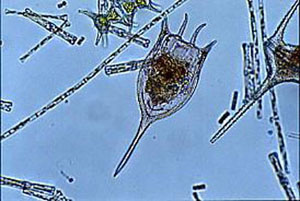
In the sea there are many taxonomical groups and all of them are represented except from the fungi. We are going to analyze some of them:
Kingdom of Monera
This kingdom includes the bacteria that have the main role of decomposing. They live on the sea bottom and on the seaweeds that form the phytoplankton. They are the most simple and ancient human beings in the world.
Source: The marine environment by Alfredo De Luca Translated by Pia GrassoProtist kingdom
Note: The categorization of human beings is called taxonomy and it divides them into groups. The main groups are: kingdom, Phylum, category, species and gender.
The kingdoms are five: Moneras (Unicellular organism: bacteria and blue- green algae); Protists (unicellular eucaryotes: unicellular algae and organisms that form part of the plankton); fungi (multicellular eterotrophes, they don’t live in the sea); Plants (multicellular autotrophs: they live in the sea like algae and plants); Animals (multicellular eterotrophes: there are many phylum).
Protists are divided into unicellular algae and protozoans. Unicellular algae range from single-celled forms to multicellular forms and their concentration is a sign of how many species live in the sea because they are the main food of herbivorous which in turn are eaten by the carnivorous. The 90% of phytoplankton is produced by marine species. They live at 200 mt of depth into the sea where they grow up and eat all the nourishing substances.
The protozoans are part of zooplankton which forms the main food for young marine species. It’s important the production of rotifers which are the main food for sea basses and sea breams. Both of the groups reproduce in a short period of time ( from few hours to few weeks) so they don’t have a large mass.
Source: The marine environment by Alfredo De Luca Translated by Pia GrassoAnimal Kingdom
Invertebrates
Invertebrate animals represent the main kind of marine species and are divided into many Philum. The most important will be analyzed here:
Proriferans
GA group of animals that includes the common Sponges. Their body has the shape of a sack, their membrane consist of three levels. The one in the middle has a chalky skeleton. In Proriferans with a simple organization, the tissue of their body have many holes through which the water flows towards the gastrointestinal cavity. They have different shapes, they don’t live at high temperatures and with much light.
Polyps
It’s a group of animals that includes jellyfishes, corals, and Actinias. They are pluricellular organisms characterized by particular cells to defend themselves. Inside their body they have a gastrointestinal cavity and they communicate with the external environment through a hole. Marine animals are divided into two main groups: the polyps and the jellyfishes. Sessile organisms live in colonies. They are divided into three groups: Hydrozoa (tipycal corals), Scyphozoa (jellyfishes) and Anthozoa (sessile polyps whom the Mediterranean Red Corals belong to, Gorgonians, Anemones of the sea, Ceriantes and Madreporas).
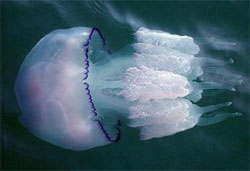
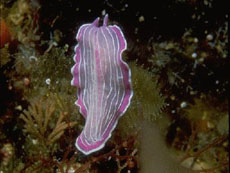
Platyhelminthes
They are a phylum of relatively simple bilaterarians, unsegmented, soft-bodied invertebrate animals. Unlike other bilaterians, they have no body cavity, and no specialized circulatory and respiratory organs, which restricts them to having flattened shapes that allow oxygen and nutrients to pass through their bodies by diffusion.
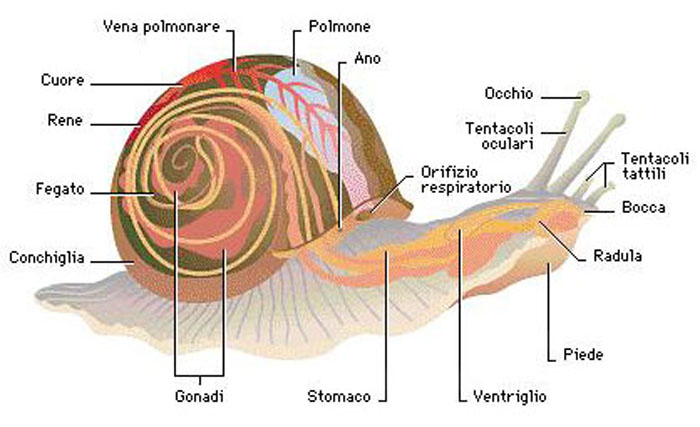
Mollusks
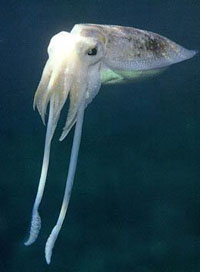
Mollusks have such a varied range of body structures, it is difficult to find defining characteristics to apply to all modern groups. The two most universal features are a mantle with a significant cavity used for breathing and excretion, and the structure of the nervous system. As a result of this wide diversity, many textbooks base their descriptions on a hypothetical "generalized mollusc". This has a single, "limpet-like" shell on top, which is made of proteins and chitin reinforced with calcium carbonate, and is secreted by a mantle covering the whole upper surface. The underside of the animal consists of a single muscular "foot". Although mollusks are coelomates, the coelom is very small, and the main body cavity is a hemocoel through which blood circulates; their circulatory systems are mainly open. The "generalized" mollusc's feeding system consists of a rasping "tongue", the radula, and a complex digestive system in which exuded mucus and microscopic, muscle-powered "hairs" called cilia play various important roles. The "generalized mollusc" has two paired nerve cords, or three in bivalves. The brain, in species that have one, encircles the esophagus. Most mollusks have eyes, and all have sensors to detect chemicals, vibrations, and touch. The simplest type of molluscan reproductive system relies on external fertilization, but more complex variations occur. All produce eggs, from which may emerge trochophore larvae, more complex veliger larvae, or miniature adults. A striking feature of mollusks is the use of the same organ for multiple functions. For example, the heart andnephridia ("kidneys") are important parts of the reproductive system, as well as the circulatory and excretory systems; in bivalves, the gills both "breathe" and produce a water current in the mantle cavity, which is important for excretion and reproduction. They are classified in seven types: Monoplacophora, Placophora, Solenogastes, Cephalopoda, Scaphopoda, Gastrophoda and Bivalvia.
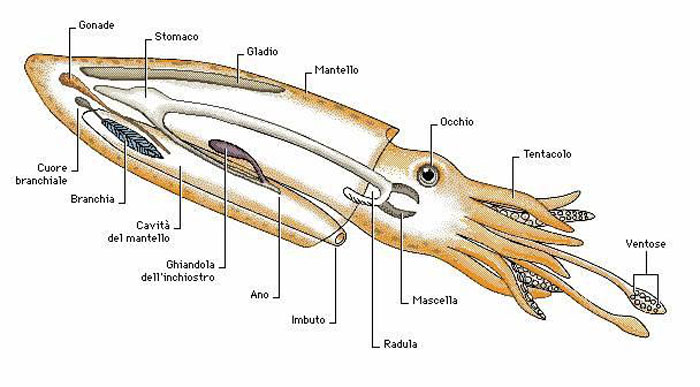
Bivalvias: the thick shell and rounded shape of bivalves make them awkward for potential predators to tackle. The bivalves are a highly successful class of invertebrates found in aquatic habitats throughout the world. Most are infaunal and live buried in sediment on the seabed, or in the sediment in freshwater habitats. A large number of bivalve species are found in the intertidal and sublittoral zones of the oceans. A sandy sea beach may superficially appear to be devoid of life, but there is often a very large number of bivalves and other invertebrates living beneath the surface of the sand. France in the main producer, followed by Italy and Spain.
Gastrophodas: most shelled gastropods have a one piece shell, typically coiled. In the land slugs, the shell is absent. Many species are used for cooking such as : Littorines, Buccins, Murices, Patella.
Cephalopodas: they are widely regarded as the most intelligent of the invertebrates. The mantle becomes the organ of propulsion. The shell is absent or it’s inside. They have complex eyes and a nervous system. There is also a gland for squirting ink. Squids, cuttlefishes and polyps belong to this category. They are very appreciated in Mediterranean countries.
Artrophods
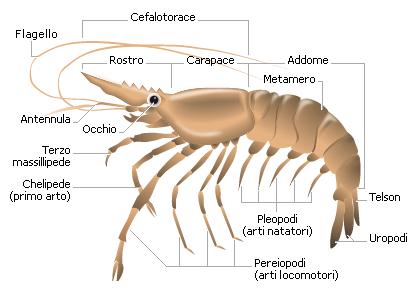 They have an exoskeleton and a segmented body. In the sea they are represented by crustaceans. Most of crustaceans are aquatic animals, their body is composed of two regions: the cephalotorax and the abdomen. On their head they have a pair of appendages: the first one includes the eyes followed by the antennae and the mandibles. Many crustaceans are consumed by humans, some of these includes crabs, prawns and lobsters.
They have an exoskeleton and a segmented body. In the sea they are represented by crustaceans. Most of crustaceans are aquatic animals, their body is composed of two regions: the cephalotorax and the abdomen. On their head they have a pair of appendages: the first one includes the eyes followed by the antennae and the mandibles. Many crustaceans are consumed by humans, some of these includes crabs, prawns and lobsters.
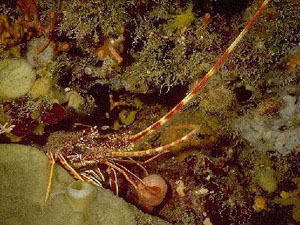
Most species have long, spirally curved abdomens, which are soft, unlike the hard, calcified abdomens seen in related crustaceans. The vulnerable abdomen is protected from predators by a salvaged empty seashell carried by the hermit crab, into which its whole body can retract. The prawns that we sell in Europe come from a variety of regions. They live in the mud or on the rocks. They fish them with trawl nets, on the sea bottom, or with lobster pots. Some of them come from fish breedings set in the Tropics. Lobsters and crabs live on rocky sea bottoms. The first ones come from Atlantic coasts, while crabs come from the Mediterranean coasts.
Echinoderms

They are exclusively marine. The biomineral matrix of echinoderm skeletons is composed of calcium carbonate and several proteins. The calcite is deposited as numerous tiny crystals, but all of them lie on the same crystal axis within an ossicle. For this reason, ossicles are birefringent under polarizing light. Ossicles are not solid, but have a sponge-like microstructure called stereom that is unique to the phylum. Embryologically, echinoderm ossicles are a true endoskeleton, since they are produced by mesenchymal cells and are usually covered by epidermis. Functionally, however, the majority of ossicles act more like an exoskeleton, lying just under the epidermis and enclosing most other tissues in a flexible but tough covering.The water vascular system performs many important functions in echinoderms, including locomotion, respiration, and feeding; in addition, most sensory neurons are located at the termini of podia (tubefeet) which are part of this organ system. Reproduction is external, they have different ways of feeding. In Europe sea urchins are very popular, especially in countries by the Mediterranean sea.
Chordata ( subphylum vertebrata)
They have a spinal column and a skull. In the sea there are fishes, reptiles and mammals.
Fish
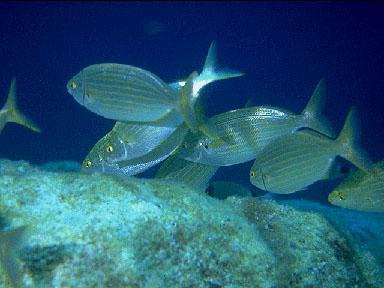
This class is divided in Chondrichthyes (cartilaginous fishes) and Osteichthyes (with a partially bony skeleton ). They have a long body covered with scales and fins. The skeleton can be cartilaginous or partly ossified.
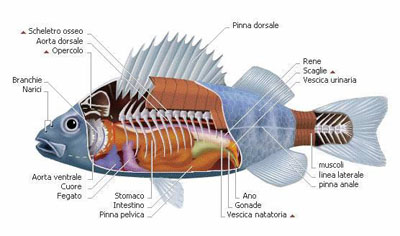
This kind of fish needs to have oxygen in the water to live. The oxygen can be used through its gills that play the role of lungs. They always needs to be wet. Most of fishes open and close their mouth in order to create a water flow. Reproduction is always external, males and females of the same species meet together to lay their eggs. Both of them deposit their reproductive cells into the water but only few eggs reach adulthood. Each member develop a particular behavior to reproduce and survive. The species can only reproduce in a suitable environment for them with the right light, saltiness of water and amount of oxygen. The nervous system is based on the sense of smell. Through this organ they can feel the change of pressure in the water and they can identify the predator. The young salmons can recognize the smell and the taste of the water where they were born and when they find it they reproduce there. If the water is polluted they can’t find their way anymore. .
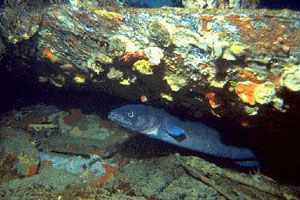
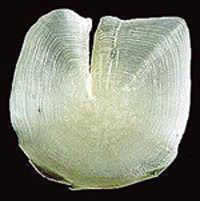
The scales have a protective function, each year there is one more. Their number shows the age of the fish.
Reptiles
Analysis::Tartanet project plans to build some centers for the rescue of turtles along the Italian coasts to preserve the Caretta. Every year there are 60.000 turtles captured by the fishermen in the Mediterranean Sea. 10.000 turtles are captured in Italy with a death rate that goes from 10% to 50%. Among the other dangerous factors there is the pollution of the water due to the tourism along the coasts where they should lay their eggs. Tartanet centers help to safeguard the life of injured turtles, they look after them and they release them.
The most famous are marine turtles. They are generally found in hot marine waters, they come ashore to lay their eggs on sandy beaches during the nesting season. Apart from marine turtles there are also marine snakes, they live in tropical areas of the Pacific and Indian Oceans. They don’t have big dimensions, they measure 1 mt approximately.
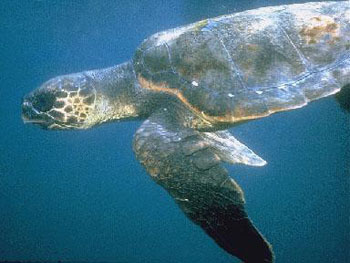
Mammals
Most mammals are viviparous, they nourish their young through mammary glands specialized to produce milk. In the sea we can find animals that are members of the classes of Cetacea, Sirenia and Pinnipedia. During their evolution some mammals adapted again to sea life: among these there are Pinnipeds including seals and sea lions, they sleep and reproduce ashore. The adaptation to sea life didn’t stop Sirenians and Cetaceans from being viviparous and nourishing their young. Thanks to the disappearing of hind legs they move like fishes and they have a tail with two lobes.
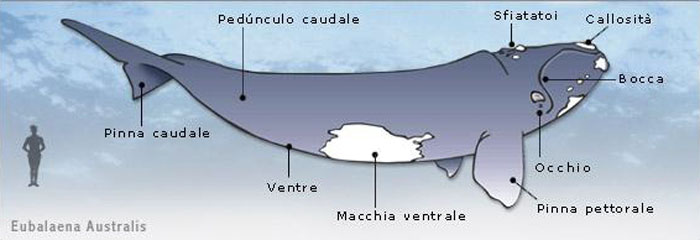
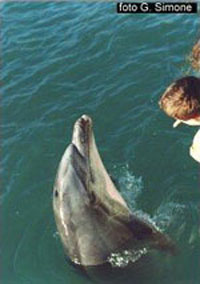
Cetaceans includes species that have developed a particular structure consequently to the adaptation to sea life: their body is spindly , the forelimbs are modified into flippers and the tiny hind limbs are vestigial; they do not attach to the backbone and are hidden within the body. The tail has horizontal flukes. Cetaceans live in the sea with other groups of animals and they can reach large dimensions. The whales can reach 30 mt and 150.000 kilograms, thanks to the pressure of the water that support them. They don’t come out of the water even to reproduce. They are grouped into two suborders: Odontoceti and Mysticeti. Mysticeti are macrophages because they nourish with zooplankton while Odontoceti like il the Sperm Whales, the Orcas, the Narwhals e dolphins are hunters.
Analysis::When we talk about dolphins, we refer to different species of which six can be found in the Mediterranean Sea and three are very common: the Bettlnose Dophins, the Spinner Dolphins and common dolphins. Tursiopi are the biggest and strongest ones, ( up to 4 mt and 350 kilograms), they live in pods of few members and they have a changeable behavior , sometimes they are suspicious and sometimes they like to play. The Spinner Dolphins are thinner and smaller ( up to 2,5 mt and 150 kilograms), they are social and they live in big pods. All of them eat fishes and some of them nourish with mollusks. Dolphins usually like to imitate and they have a good vocabulary: they communicate using a variety of clicks, whistle-like sounds and other vocalizations. Through dolphins we can communicate with deaf people. Generally, dolphins sleep with only one brain hemisphere in slow-wave sleep at a time, thus maintaining enough consciousness to breathe and to watch for possible predators and other threats. Every year thousands of dolphins are captured or killed by the man, they also die because of the pollution in the water and for epidemics of bacteria and viruses.
Plant Kingdom
Algae
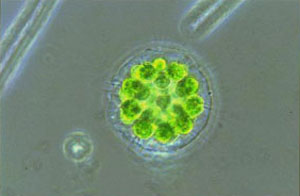
In the sea plants are represented by algae and few higher plants (Oceanic Posidonia, Cymodocea nodosa and some species of the genus Zostera) we have already talked about.
Algae can be referred to as plant-like organisms that are usually aquatic but do not have true roots, stems and leaves. They don’t have to be confused with the microscopic ones pertaining to Protista and the Moneras kingdom. They are distributed worldwide in the sea, some are quite large and can exceed many metres in length. They can be distinguished in green, red and brown algae. Their name depends on the pigments that characterize them, through these pigments they can recognize different radiations of the sun. Green algae live ashore, brown algae live at 50 metres of depth in the sea and red algae at 150 metres.
Note: In biology binomial nomenclature is used to name the species. The scientific name is given from the combination of two names: the first one is general and it is written with a capital letter, while the second one is more specific and it is written with a lower letter. Both of the names are written in cursive.
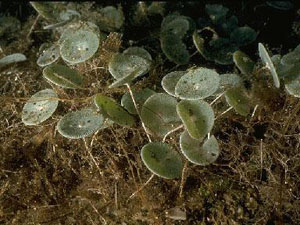
Algae can be used in different ways:
Nutrition: Algae have been used for many years in the diet of Asian people.
In Europe people don’t have a good opinion about algae, in some Regions algae are used in periods of famine and extreme poverty. Despite that the consumption of algae is growing slowly. Eating 10 g of algae each day helps to supply the food requirement of vitamins and mineral salts of human beings
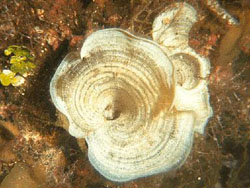
Food additive: in Europe we eat algae as food additive, we can find them in many products such as mayonnaise, milk food, ketchup, fruit juices and cakes. Additives from E400 to E407 are obtained from algae.
Agriculture: In some countries algae are used as fertilizer for the fields. Algae are also used as nutritional supplement for the animals because of their nutritional properties.
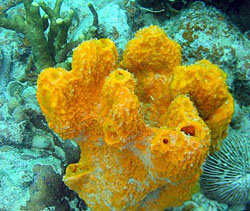 Health: we can find algae in many pharmaceutical products as well, such as creams and laxatives.
Health: we can find algae in many pharmaceutical products as well, such as creams and laxatives.
Aquaculture: We use micro algae that form the phytoplankton that is the main source to nourish mollusks and zooplankton.
For the textile industry: are used for the fabrics as well.
Cosmetic industry: Algae were used by Romanian ladies for their makeup. Nowadays many cosmetics contains algae such as lipsticks, toothpastes, facial creams and facial masks.



